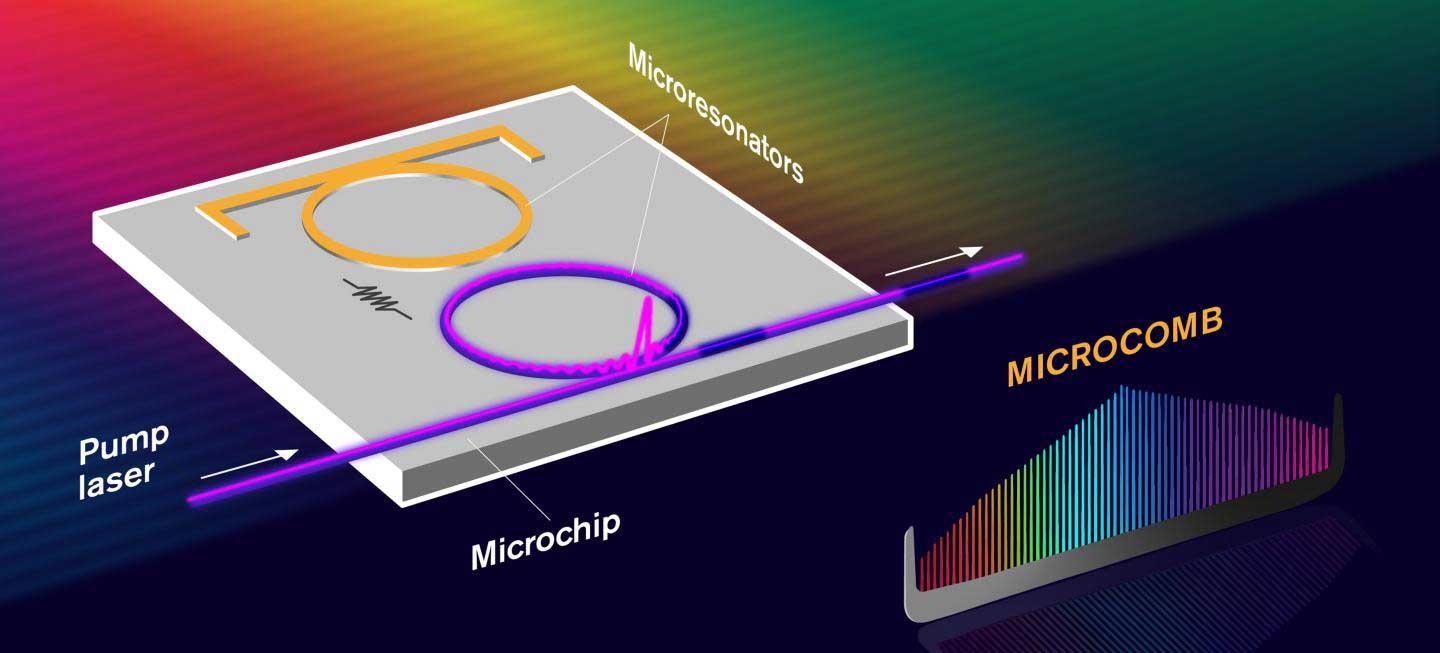
Image Credit: Yen Strandqvist/Chalmers
Microcombs are small photonic devices that could help improve the energy efficiency of the internet, monitor our health, or even discover new Earth-like exoplanets. Swedish researchers have developed a unique, game-changing microcomb that could bring these advanced applications a step closer.
What is a Microcomb?
A frequency comb is a unique laser source where the emission spectrum consists of a series of discrete, equally spaced frequency lines. It works similarly to a ruler made of light; markers set the frequency scale across the electromagnetic spectrum from ultraviolet to the mid-infrared, with each marker's location linked to a known reference.
A microcomb works similarly by generating repetitive pulses of light at incredible speed by sending laser light to a small optical cavity called a microresonator. Like the frequency comb, the colors - or optical frequencies - are equally spaced so the microcomb acts like a ruler of light, which can be used to measure or generate frequencies with extreme precision.
The frequency spacing between markers is larger than those found in frequency combs, making them ideal for photonic integration technology and many other novel applications, including light sources for fiber-optic communication systems or creating pure microwave electromagnetic radiation.
Unique Enhancements
What is different about the enhanced microcomb from Sweden’s Chalmers University of Technology is that it uses two microresonators instead of one. These microresonators interact with each other just like atoms when they bind together, forming a photonic molecule with unique physical characteristics.
The game-changing microcomb – which is positioned on a chip and is so small that it fits on the end of a human hair - has overcome many well-known limitations in the field to produce a comprehensible, tunable and reproducible device with up to ten times higher net conversion efficiency than current technology.
"The reason why the results are important is that they represent a unique combination of characteristics, in terms of efficiency, low-power operation, and control, that are unprecedented in the field,” says Óskar Bjarki Helgason, a PhD student at the Department of Microtechnology and Nanoscience at Chalmers and lead author of the paper published in Nature Photonics.
It is All About Spacing
The gaps between the comb’s teeth are very wide, and, as almost any measurement can be linked to frequency, researchers and engineers have the opportunity to use it in numerous applications. They could massively decrease the power consumption in optical communication systems by replacing several lasers with a single chip-scale microcomb in data center interconnects.
Other uses include measuring distances in autonomous cars using lidar or calibration of spectrographs used in astronomical observatories searching for Earth-like exoplanets. Microcombs could also be used to analyze exhaled air composition to help diagnose diseases earlier, in health-monitoring apps on mobile phones, or in highly accurate optical clocks.
However, the practical use of microcombs is still some way off: “For the technology to be practical and find its use outside the lab, we need to co-integrate additional elements with the microresonators, such as lasers, modulators and control electronics,” explains Victor Torres Company, Associate Professor and research leader of the project.
He describes this as a huge challenge that will require a further five to ten years and an investment in engineering research: “But I am convinced that it will happen,” he states, adding that the most interesting advances and applications are the ones that we have not even conceived of yet.
“This will likely be enabled by the possibility of having multiple microcombs on the same chip. What could we achieve with tens of microcombs that we cannot do with one?”
References and Further Reading
Palmgren, M. (2021) New microcomb could detect exoplanets and diseases, Chalmers University of Technology. https://www.chalmers.se/en/. Accessed 16 March 2021.
Helgason, Ó.B. et al. (2021) Dissipative solitons in photonic molecules, Nature Photonics [Online] https://doi.org/10.1038/s41566-020-00757-9
Chalmers University of Technology (2018) Multiple lasers could be replaced by a single microcomb, Phys Org [Online] https://phys.org/news/2018-06-multiple-lasers-microcomb.html. Accessed 16 March 2021.
Disclaimer: The views expressed here are those of the author expressed in their private capacity and do not necessarily represent the views of AZoM.com Limited T/A AZoNetwork the owner and operator of this website. This disclaimer forms part of the Terms and conditions of use of this website.